- Home
- Peter Ackroyd
Venice Page 7
Venice Read online
Page 7
Jews and Christians would mingle in the ghetto during the day, and in fact the ghetto exercised a peculiar fascination for some members of Venetian society. The government of Venice tried to prevent its citizens from attending the Purim plays, for example, but in the face of mounting protest gave up the attempt. There was simply too much enthusiasm. Certain Venetians would also regularly attend the synagogues, when a renowned or gifted speaker was about to deliver the sermon. In turn rabbis would listen to the sermons in Venetian churches. There may in fact have existed an affinity deeper than either the Jews or Venetians would care to confess. There were many similarities. Both people were intent upon custom and ceremony; the Venetian patricians were often described as “grave” and “dignified,” in a fashion similar to Jewish elders. And the mercantile Venetians, like the Jews, were subject to vulgar prejudice. Other countries accused them of “insatiable cupidity” and of “conspiring the ruin of everyone.” The rest of the world believed that Venice was extraordinarily wealthy, even though it took great pains to conceal its wealth. Similar charges had been levelled at the Jews in all ages. There was a fellow feeling. They were both hated.
So in Venice the Jews were tolerated in a manner not evident in other European cities. There is no example of popular execration or maltreatment, although it was reported that Venetian drunks or Venetian children would sometimes dance in the Jewish graveyard on the Lido. The Jews were tolerated, perhaps, because they were profitable. You can never ignore the principle of commercial calculation running through all of Venice’s affairs. Jews were allowed to open business premises only on the payment of large fees. The trade that Jewish merchants and shopkeepers brought to Venice was of immense service to the Venetians themselves. The relatives of the Venetian Jews often sent their capital to the city. At times of crisis, not infrequent, heavy taxes were levied against the ghetto. In the first decades of the seventeenth century it has been estimated that the net revenue received from the ghetto was approximately 220,000 ducats; the sum was much higher than any collected from Venice’s overseas or mainland colonies.
Yet a more exalted association can be placed beside this talk of taxes and ducats. It is significant, for example, that both Venetians and Jews had a solemn sense of law and a sacred belief in nationhood. They both shared a preoccupation with their native territory as a common heritage. They both believed that their constitution was in essence a covenant between deity and people. They both reverenced their forefathers, and had an inordinate respect for custom and tradition. The Jews knew themselves to be mutually interdependent, part of a communal life rendered ever more sacred by a common purpose and the necessity of self-preservation. Does this not remind us of the Venetian state? The two cultures were images one of another.
The Battle of Lepanto, painted by Paolo Veronese in 1571. This work was completed just a few months after a famous victory of the Venetian forces (among others) over the Turks. Two hundred and thirty Turkish vessels were sunk or captured, with only thirteen losses for the Europeans. Lepanto was the last battle in which the use of the oar held the key. In later engagements the sails were raised. (photo credit i2.1)
Plan of the Arsenal in the seventeenth century. The Arsenal of Venice was the largest shipbuilding enterprise in the world, with its own network of docks and system of production lines. Ships were turned out from the shipbuilding yards of the Arsenal fully rigged and fitted, in the first version of the capitalist factory. (photo credit i2.2)
Detail of a Venetian warship, taken from the mausoleum of Girolamo Michiel completed in 1559. The image of the ship, and the circumambient sea, can be glimpsed everywhere in Venice. The city itself can be seen as a ship upon the waves. (photo credit i2.3)
The sign for the Marangoni family of shipbuilders, painted on panel in 1517. Shipbuilding was of course one of the principal crafts of a city surrounded by water. Ship-builders offered defence, and protection, against the watery element. (photo credit i2.4)
Jan van Grevenbroeck’s painting of a workman dredging a canal, an image of the eighteenth century. In all periods of Venetian history the government was involved in major efforts concerning health care and sanitation. (photo credit i2.5)
Jan van Grevenbroeck’s painting of an oar-maker at work in Arsenal. Oar-making was one of the many Venetian trades springing from the sea. The oar was used in the perpetual battle against the natural world and in warfare against the city’s competitors. (photo credit i2.6)
A painting of a Venetian doctor during the time of plague, by Jan van Grevenbroeck. During the time of pestilence the doctors clothed themselves in black robes, coated with wax and aromatic oils; they wore a hood and cowl over their heads, large glasses to protect their eyes, and a long beak-like nose with a filter at its end. They looked themselves like ghouls. (photo credit i2.7)
The shop of a Venetian bell-maker, at the end of the eighteenth century, painted by Jan van Grevenbroeck. Venice was a city of bells, all of them pealing together at the time of processions. They also had a more practical use. The bells rang out at precise times of day to coordinate the activities of the populace. (photo credit i2.8)
A showroom with lamps and vases. For many centuries Venice has been famous for its glass-making, now the preponderant industry on the island of Murano. What is the attraction of glass for the city of the sea? Glass is material sea. It is sea made solid, its translucence captured and held immobile. (photo credit i2.9)
Lace workers on the island of Burano, photographed at the end of the nineteenth century. Burano has been for many centuries the home of lace-making in Venice. Lace is a Venetian specialty; like the mosaic it is an art of elaboration and intricacy. (photo credit i2.10)
A Venetian courtyard at the end of the nineteenth century. Venice is a city of dead-ends, and of circuitous alleys; there are twisting calli, and hidden turnings; there are low archways and blank courtyards, where the silence is suspended like a mist. (photo credit i2.11)
A photograph of a funeral gondola, taken at the beginning of the twentieth century. Venice has always been associated with death, and the gondola itself has often been viewed as a floating hearse. (photo credit i2.12)
The new railway bridge over the lagoon, depicted in the middle of the nineteenth century. The bridge represented perhaps the most radical change in the history of Venice. It became connected to the mainland. The city was no longer an island, and had lost its hallowed status as a refuge from the world. It meant, too, that the prime significance of the water had gone forever. It became a city of mechanical, rather than of natural, time. (photo credit i2.13)
The remains of the campanile, which collapsed on 27 July 1902. It buckled and folded upon itself, neatly imploding into a large pile of rubble. It fell, as the Venetians said at the time, “like a gentleman.” There were no fatalities, except that of the caretaker’s cat. (photo credit i2.14)
An illustration taken from The Stones of Venice by John Ruskin, displaying types of the windows from the early Gothic palaces. The style was dominant in the fourteenth and fifteenth centuries, surviving even into the sixteenth century and giving an unmistakeable aspect to the city that still survives. Most of the well-known palaces or great houses are created in the Gothic mode. (photo credit i2.15)
6
Against Nature
There were once many gardens in Venice. In the sixteenth century there were five hundred of them nestling within the city, spreading their own refreshing and aromatic life. Yet by the eighteenth century Casanova remarked that “a garden is a rarity in Venice.” In the middle of the twentieth century it was estimated that there were sixty remaining. That number may have since been revised. Yet there are still gardens, secluded and still, protected by walls and gates, creating little pockets of green in the stony life of the city. In previous centuries the smaller gardens might have shrubberies of larch or cypress or laurel. The larger gardens were planted with flower-beds and avenues of fruit-trees, complete with cages of singing birds to maintain the illusion of nature. There we
re also, in the largest of them, temples and fountains as well as elaborate loggias. The fugitive scent of fruit and jasmine and banksia roses trailed through the calli and the campi.
The Venetians evinced a great love for flowers, matched only by their love of buildings. There were itinerant sellers of gladiolas and tuberoses, and other blossoms harvested from the mainland. On describing these merchants in 1623, Sir Henry Wotton coined the English word florist. It entered the vocabulary effortlessly. On Saint Mark’s Day it was the custom for each young Venetian man to offer a rosebud to his sweetheart. In painted representations of Venice in the fifteenth century, there are innumerable pots of carnations cluttering the window-sills. But tastes change. In the early decades of the twentieth century, the aspidistra became the flower of Venice. There was, however, one native flower. It was the flower of the lagoon, fiore di barena, clothing the level marshes with a purple robe. It is a token of that time when Venice itself was merely a heap of wild and uncultivated nature.
On the lagoon itself there were garden islands. In the fifteenth century there were vineyards and monastery gardens. The island of Giudecca was until recent years a paradise of gardens. The island of Torcello was the home of the vine and the pomegranate, the oleander and the acacia, the fig and the elder tree; it also provided the rich soil for maize and artichoke. Once there were olive trees all over Venice. The island of Castello, where the cathedral of the city stands, was once known as Olivolo. Olive oil was a profitable commodity.
Yet in the city itself there is no sense of regeneration or rebirth that accompanies the presence of flora and foliage. It has been said that the Venetians prefer marble to vegetation. In Venice architecture must take the place of nature. It must allude to nature in a pious and consolatory manner. It is one of the secrets of Venetian building. The stone of the buildings is sculpted with leaf and branch. The hundred columns of Saint Mark’s comprise a solemn forest. The wood becomes stone. The stone becomes wood. The great houses have also been compared to coral reefs.
It needed art to re-create nature. There was a fashion among Venetian painters of the early sixteenth century for pastoral scenes. But the natural world is pictured without life. It is not worked or populated. There are sheep. There are picturesque rustic buildings. There are groves and springs. There are nymphs and shepherds in the foreground. The inner reality of rural life is not understood. The grass is depicted as if it were velvet, for example, just as in Venetian manufactories velvet was created to resemble grass.
The natural life of the city must be imagined rather than seen. It must be intuited beneath the layers of stone. Byron called Venice “the greenest isle of my imagination,” a paradox only he could sustain. George Aschenbach, the protagonist of Thomas Mann’s Death in Venice, sees in vision “a landscape, a tropical marshland … a kind of primaeval wilderness-world of islands, morasses and alluvial channels.” It is a vision of Venice itself in its original state. But it is a city that no one else will ever see.
And what kind of animals prowl in this city of stone? There were once sheep and oxen. There were foxes, and even wolves. There were horses and mules in the streets of Venice. In 1177 a mule carried Pope Alexander III through the streets of Venice, and in 1361 the doge and eleven patricians entered the city on horseback. The Veneti of early time had been known for their skill on horseback, and the latter-day Venetians continued their practice. Eighty horsemen were deployed in Saint Mark’s Square, in 1310, to maintain public discipline after the discovery of a conspiracy against the state. There were tournaments in the square, and at one such display in 1364 Petrarch was moved to remark that the Venetians demonstrated horsemanship and weapon-handling enough to equal “the fiercest fighters on earth.” There were horse-races across the Rialto bridge until they were banned by edict in 1359. It was a city where one of the principal sounds was that of the clangour and neighing of horses. This did not endure, however.
In 1611 the English traveller, Thomas Coryat, reported seeing only one horse in the entire city. Horses were eventually barred from the streets. There was simply not enough room, and the spread of stepped stone bridges was a further impediment. Such was their rarity that, in 1789, Mrs. Thrale noticed a line of Venetians queuing to marvel at a stuffed horse. Indeed by the eighteenth century the patricians of Venice were ridiculed for their inability to ride on anything except gondolas. It shows that a native skill may disappear from sheer lack of practice. The only horses now to be seen in the city are those with the rigid composure of metal. The four bronze chargers panting on the façade of Saint Mark’s, the spoils of war looted from Constantinople, are a token of a city where natural life is coming to an end.
Cats and dogs were, and are, popular in Venice. Once the city was filled with watch-dogs and hunting dogs for deployment in the lagoon. But over the centuries they have become more discreet. They are relatively small and domestic. They consort well with the spaces of the city. The dogs in particular enjoy the savour of old stone. They have a distinct sense of territory, as Venetians also do. The Venetian painters loved dogs. Carpaccio enjoyed their company on canvas. In one of his most famous paintings, now to be found in S. Giorgio degli Schiavoni, a small terrier looks up expectantly at Saint Jerome (or perhaps Saint Augustine) lost in divine rapture. Nature looks on, bemused, at the supernatural. But he also paints dogs on guard, dogs asleep, dogs on verandas and dogs on gondolas. They were not reserved for patricians. Almost all of the numbers of the local newspaper in the eighteenth century, the Gazzetta Veneta, contain advertisements for lost dogs. The Venetians embraced them because they were one of the tokens of the larger natural world that they had forfeited in their struggle for survival. In the modern vaporetti, the dogs are all safely muzzled.
The cats were celebrated as the “little lions” of Venetian life. They are part of the territory. They are naturally lazy. They are naturally observant, and can spend much of their day simply looking on. Yet cats, unlike most breeds of dogs, do not like water. They can still be found in feral groups, scattered across the city. They haunt the fish-market. They can be seen on ledges, on steps, under bridges and in the squares. The square of S. Lorenzo is particularly graced by cats. They are useful, of course, in catching the rats. Rats are one of the curses of Venice, but one surprisingly little mentioned in the literature of the place. There is a saying in Venice that every house has a rat; by which is meant that every family has a renegade member. But it can also be taken literally.
The efficacy of cats against the pests may have prompted the Venetian superstition that he who kills a cat will die within a year, and that he who hurts a cat will suffer an accident. This did not deter the more serious cat-haters. There were once mysterious outbreaks of cat-poisoning in the republic, and a curious ritual in which a cat tethered with a board was killed by systematic head-butting from the Venetian crowd. Yet there has always been a general celebration of animal life in the republic. Late medieval and early Renaissance painting is filled with animal studies; Carpaccio and Crevelli, Tintoretto and Veronese and Bellini, depict cats and dogs and falcons and deer and pheasants. Titian painted white rabbits. In every case there was a desire to embrace a natural world which was in truth out of reach, all the more fervently loved for being elusive.
There were aviaries and cages of singing birds all over Venice, another reminder of a natural life elsewhere. Brightly coloured birds—finches, canaries and parrots—were the favourites. All these birds had, of course, to be imported. In the sixteenth and seventeenth centuries the apothecaries of the principal shopping street, the Merceria, kept cages of nightingales to advertise their trade. John Evelyn reported that “shutting your Eyes, you would imagine your selfe in the Country, when indeede you are in the middle of the Sea.” The pursuit of nature was for the Venetians a way of forgetting the unnatural and precarious position in which they lived.
Browning loved the seagulls of Venice, although they are seldom mentioned in the annals of the city. Yet the seagulls should be named with the cranes a
nd the wild ducks as the native birds of the lagoon. They are also part of the myth of the city, like the flight of birds that led the earliest settlers to the islands of the lagoon. There is a legend that the pigeons of Saint Mark’s Square are a direct descendant of those flocks that followed the exiles from the town of Oderzo in their flight from the barbarians. The swallows provide another blessing. They come in summer, and swoop down upon the mosquitoes that are the plague of the shallow waters.
No one can visit Venice, however, without being aware of the pigeons. Those in Saint Mark’s Square are the most pampered and preserved birds in the world, to the extent that they have acquired an absolute immunity from the passing human population. In times of frost or heavy rain they will literally form a pile, one upon the other, creating and maintaining warmth in their huddled masses. They know that they are not at risk from predators, and that they will not be disturbed. So they have developed a unique form of animal behaviour, like some remote island species on a distant sea.
They are protected by ancient custom. And custom, in Venice, is sacrosanct. It is said that on one Palm Sunday they were released from the basilica of Saint Mark, with small weights tied to their legs. Hampered in this manner, they became easy prey for the dinner-tables of the Venetians. But some of the birds still somehow managed to escape, and found refuge on the various ledges and alcoves of Saint Mark’s itself. So they were preserved by the intervention of the saint. After that, they became a cult bird. So the story goes. It is certainly true that a daily supply of grain was provided to them from the public granaries, as was the custom in Persia and in southern Russia, and that it became an offence to injure or molest them in any way.

 The Clerkenwell Tales
The Clerkenwell Tales The Canterbury Tales
The Canterbury Tales J. M. W. Turner
J. M. W. Turner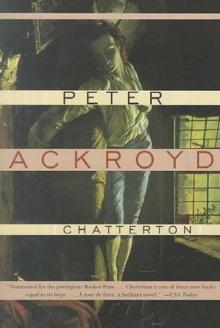 Chatterton
Chatterton The Canterbury Tales – A Retelling
The Canterbury Tales – A Retelling Alfred Hitchcock
Alfred Hitchcock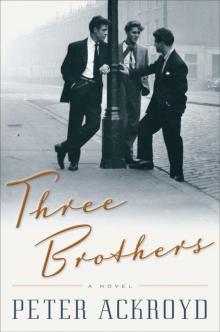 Three Brothers
Three Brothers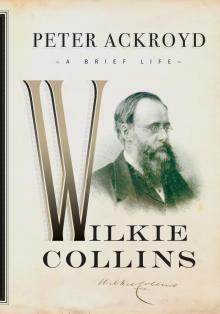 Wilkie Collins
Wilkie Collins Venice
Venice Poe
Poe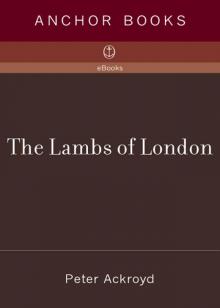 The Lambs of London
The Lambs of London London
London Queer City
Queer City Revolution, a History of England, Volume 4
Revolution, a History of England, Volume 4 Venice: Pure City
Venice: Pure City Foundation
Foundation Thames
Thames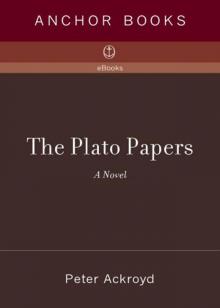 The Plato Papers
The Plato Papers The house of Doctor Dee
The house of Doctor Dee Rebellion: The History of England from James I to the Glorious Revolution
Rebellion: The History of England from James I to the Glorious Revolution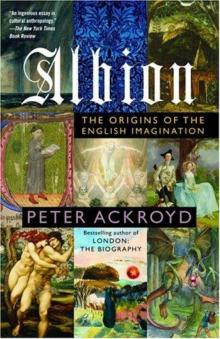 Albion: The Origins of the English Imagination
Albion: The Origins of the English Imagination The Fall of Troy
The Fall of Troy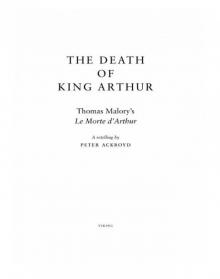 The Death of King Arthur
The Death of King Arthur The Trial of Elizabeth Cree
The Trial of Elizabeth Cree London: The Biography
London: The Biography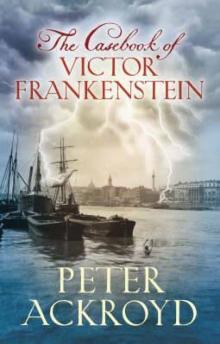 The Casebook of Victor Frankenstein
The Casebook of Victor Frankenstein Hawksmoor
Hawksmoor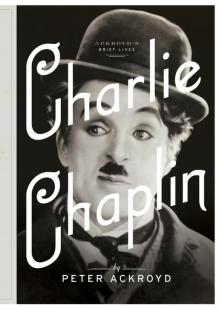 Charlie Chaplin
Charlie Chaplin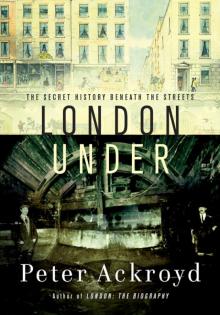 London Under
London Under